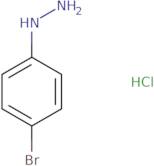p-BromophenylHydrazine
CAS: 41931-18-4
Ref. 3D-FB149726
| 1g | Descatalogado | ||
| 2g | Descatalogado | ||
| 5g | Descatalogado | ||
| 10g | Descatalogado | ||
| 25g | Descatalogado |
Información del producto
- (4-Bromophenyl)Hydrazine Hydrochloride (1:1)
- (4-Bromophenyl)hydrazine HCl
- 1-(4-Bromophenyl)Hydrazine Hydrochloride
- 4-Bromo Phenyl Hydrazine Hydrochloride
- 4-Bromophenylhydrazine Hcl
- 4-Bromophenylhydrazine Monohydrochloride
- 4-Bromophenylhydrazinium Chloride
- 4-Bromophenylhydrazinium(1+) Chloride
- Bromophenylhydrazine hydrochloride, 4-
- Buttpark 96\57-56
- Ver más sinónimos
- Hydrazine, (4-bromophenyl)-, hydrochloride
- Hydrazine, (4-bromophenyl)-, hydrochloride (1:?)
- Hydrazine, (p-bromophenyl)-, hydrochloride
- Labotest-Bb Lt01143342
- P-Bromophenylhydrazine Hydrochloride
p-Bromophenylhydrazine is a chemical compound that contains an hydroxyl group and a bromine atom. It is used as a precursor in the synthesis of some pharmaceuticals, including antimalarial drugs. The oxidation products of p-bromophenylhydrazine are mainly hydroxyl groups, while impurities are mainly hydrazines and hemicyanines.
Hydroxylamine reacts with acetic acid to produce hydrogen chloride gas, water and acetone. Acetone can be reacted with hydrochloric acid to produce hydroxylamine hydrochloride. Hydroxylation reactions are catalyzed by metal ions such as iron or copper, which can be found in plant roots or soil.
Hydroxylamine has been shown to inhibit enzyme activities such as galacturonic acid reductase, galactose oxidase, galactokinase, and glucosamine 6-phosphate synthase in vitro. This may





